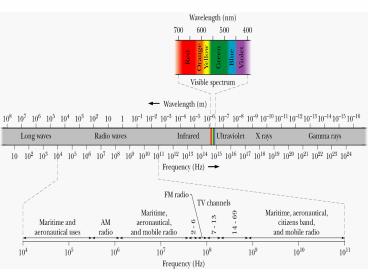Chapter 30 Interference PowerPoint PPT Presentation
1 / 19
Title: Chapter 30 Interference
1
2
Chapter 36 Interference
1 Light as a Wave
Huygens Principle
3
Wave Speed, Wavelength and Index of Refraction
In a medium with index of refraction n , the
speed of light is no longer c , the speed of
light in vacuum, but
according to Maxwells theory.
When incident light beam passes from one
medium 1 (e.g. air ) through other medium 2
(e.g. a glass), the light beam will have
different wavelengths (l1, l2) and speeds (v1 ,
v2) in two media.
From Huygens principle, it is easy to show
law of refraction
4
q1
q2
Let l be wavelength of a certain
monochromatic incident light beam in vacuum, and
ln be wavelength of the same light beam in
medium. A relation between them is
5
The frequency of light beam in a medium is given
by
which means the frequency of light does not
change in the medium.
Wave Path Difference and Phase Difference
Plane wave
Two light rays are in phase when they
pass through air.
6
They travel through two media having
different indexes of refraction
Phase difference between two light waves
Normally phase difference of two rays passing
through two media with different index of
refraction n1 and n2 is defined as follows
where is wave path
difference (???) or path length difference.
7
2 Youngs Interference Experiment
Locating the Fringes
What appears at each point on the viewing
screen in a Youngs double-slit interference
experiment is determined by the path length
difference DL of the rays reaching that point.
8
(No Transcript)
9
Sample problem 36-2
Intensity in Double-slit interference
If I1 I2, then
10
3 Thin Film Interference
Reflection Phase Shifts
For n1 lt n2 lt n3 , it is easy to see that the
path length difference between ray 1 and ray 2 is
L
11
n1 sinq n2 sin g, we have
For a normal incidence, g 0,
12
Discussions
- Half l loss? Phase p change when the ray is
reflected - from a larger index of refraction, such as n2gtn1
, n3 gtn2 .
2. How about n1 n3 1 lt n2 ? d ?
13
Sample problem 36-5
14
Applications
1. Wedge-shaped film (????)
For a normal incidence
It is easy to show that the distance between two
adjacent bright (or dark) fringes is
15
Sample problem 36-6
16
2. Newtons Rings (???)
From the figure one can see
For dark fringes, 2dm ml .
17
So radii of dark fringes are
Difference between two adjacent radii can be
given by
This relation shows that the larger m, the
denser of fringes. (see figure 36-34, Problem 49)
18
3. Michelsons Interferometer
Two ways to create phase difference thinking
about that and reading the text book by
yourselves.
19
Assignments 36 6P, 36 9P, 36 19P
Assignments 36 30P, 36 33P, 36 43P
Assignments 36 50P, 36 51P, 36 57P

